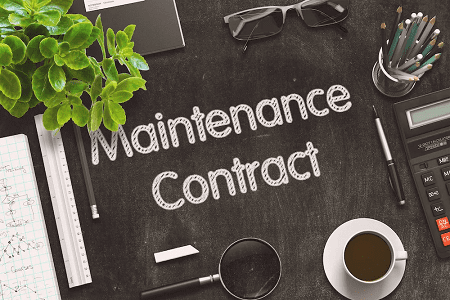Contract maintenance-
Contract maintenance involves the ongoing management and oversight of contracts to ensure they are executed as agreed and remain compliant with legal, regulatory, and organizational standards. Proper contract maintenance ensures that the obligations of all parties are met and can help avoid disputes and legal issues. Here are some key components of effective contract maintenance:
1. Contract Creation and Storage
- Standardization: Use standardized templates and language to ensure consistency and compliance with organizational policies and legal requirements.
- Centralized Repository: Store contracts in a centralized, easily accessible digital repository for efficient retrieval and management.
2. Regular Review and Updates
- Scheduled Audits: Periodically review contracts to ensure terms and conditions are being met.
- Amendments and Modifications: Update contracts as needed to reflect changes in scope, terms, or legal requirements.
3. Compliance Monitoring
- Legal and Regulatory Compliance: Ensure contracts comply with current laws and regulations.
- Internal Policies: Verify that contracts align with the organization’s internal policies and procedures.
4. Performance Management
- Milestone Tracking: Monitor key deliverables and milestones to ensure they are met on time.
- Performance Metrics: Use performance metrics to assess the fulfillment of contract terms.
5. Communication and Documentation
- Regular Communication: Maintain open lines of communication with all parties involved in the contract.
- Documentation: Keep detailed records of all communications, changes, and actions taken regarding the contract.
6. Risk Management
- Identify Risks: Recognize potential risks related to the contract and take proactive measures to mitigate them.
- Dispute Resolution: Have a clear process for resolving disputes efficiently and fairly.
7. Renewal and Termination
- Renewal Process: Develop a process for timely renewal of contracts, ensuring that all terms are still appropriate and relevant.
- Termination Clauses: Ensure contracts include clear termination clauses and follow them when ending a contract.
Tools and Software
- Contract Management Software: Utilize software tools to automate and streamline contract management processes, such as contract creation, storage, monitoring, and renewal.
Best Practices
- Training: Provide regular training for staff on contract management practices and software.
- Continuous Improvement: Regularly assess and improve contract management processes based on feedback and performance metrics.
By following these practices, organizations can effectively manage contracts, ensuring they deliver the intended value and remain compliant with relevant standards.
What is Required Contract maintenance
“Required Contract Maintenance” refers to the specific obligations and activities necessary to uphold the terms, conditions, and performance standards outlined in a contract. These maintenance requirements are essential to ensure that both parties fulfill their contractual obligations and that the agreement remains valid and effective throughout its duration. Here’s a breakdown of what typically constitutes required contract maintenance:
1. Regular Inspections and Audits
- Conduct periodic inspections or audits to verify compliance with contractual terms, quality standards, and performance metrics.
2. Documentation Management
- Maintain accurate and up-to-date documentation related to contract performance, including records of communication, deliverables, changes, and approvals.
3. Performance Monitoring
- Monitor key performance indicators (KPIs) and milestones to assess progress and ensure that performance standards are being met.
4. Scheduled Reviews and Updates
- Schedule regular contract reviews to evaluate the effectiveness of existing terms and identify any necessary amendments or updates.
5. Compliance Assurance
- Ensure compliance with legal, regulatory, and industry standards throughout the contract’s duration.
6. Risk Management
- Identify and mitigate potential risks that may impact the contract’s performance or result in breaches of agreement.
7. Communication and Dispute Resolution
- Maintain open communication channels between parties to address any issues or concerns promptly.
- Establish a structured process for resolving disputes or disagreements that may arise during the contract term.
8. Renewal and Termination Planning
- Plan for contract renewal or termination well in advance, considering factors such as performance evaluations, changing business needs, and contractual terms.
9. Resource Allocation
- Allocate sufficient resources, including personnel, time, and budget, to effectively manage and fulfill contractual obligations.
10. Training and Development
- Provide training and development opportunities for personnel involved in contract management to ensure they understand their roles and responsibilities.
11. Adherence to Contractual Requirements
- Ensure that all parties adhere to the specific requirements outlined in the contract, including deliverables, timelines, payment terms, and confidentiality agreements.
12. Record Keeping and Reporting
- Maintain comprehensive records of all contract-related activities, including performance reports, financial transactions, and correspondence.
13. Continuous Improvement
- Continuously evaluate and improve contract management processes based on feedback, lessons learned, and best practices.
Tools and Software
- Utilize contract management software or tools to streamline processes, automate tasks, and enhance efficiency and accuracy.
By diligently adhering to required contract maintenance activities, organizations can maximize the value derived from their contracts while minimizing risks and potential disputes.
Who is Required Contract maintenance
“Required Contract Maintenance” isn’t a specific person; rather, it refers to the collective responsibilities and activities that need to be undertaken by various individuals or teams within an organization to ensure that contracts are properly managed and maintained. Let’s break down the key stakeholders involved in required contract maintenance:
Contract Managers
- Responsible for overseeing the entire lifecycle of contracts, from creation to execution to renewal or termination.
- Ensure that contractual obligations are understood and fulfilled by all parties.
- Coordinate with internal teams and external stakeholders to address any issues or changes to the contract.
Legal Department
- Provides legal guidance and expertise throughout the contract lifecycle.
- Ensures that contracts comply with relevant laws, regulations, and organizational policies.
- Reviews and drafts contract terms and conditions to protect the organization’s interests.
Procurement or Purchasing Department
- Handles the negotiation, procurement, and management of contracts with vendors, suppliers, and service providers.
- Ensures that contracts meet the organization’s procurement policies and budgetary constraints.
- Monitors vendor performance and compliance with contract terms.
Finance Department
- Manages financial aspects related to contracts, such as invoicing, payments, and budgetary allocations.
- Tracks financial performance against contract terms, including payment schedules and milestones.
- Collaborates with contract managers to resolve any financial discrepancies or issues.
Operations or Project Management Teams
- Responsible for implementing and executing the activities outlined in the contract.
- Monitor project progress, deliverables, and timelines to ensure compliance with contractual obligations.
- Provide regular updates and reports on project status to contract managers and other stakeholders.
Compliance and Risk Management Teams
- Identify and mitigate potential risks associated with contract non-compliance or breaches.
- Monitor regulatory requirements and industry standards to ensure contractual compliance.
- Develop strategies and processes to address and manage contract-related risks effectively.
Executive Leadership
- Provides oversight and strategic direction for contract management activities.
- Approves high-value or strategic contracts and ensures alignment with organizational goals.
- Receives regular updates and reports on contract performance and compliance.
Contract Management Software Providers (if applicable)
- Provide software solutions to streamline contract management processes.
- Offer tools for contract creation, storage, tracking, and reporting.
- Collaborate with organizations to customize software solutions to their specific needs.
Each of these stakeholders plays a crucial role in ensuring that contracts are effectively managed and maintained throughout their lifecycle. Collaboration and communication among these parties are essential for successful contract management and compliance.
When is Required Contract maintenance
“Required Contract Maintenance” occurs throughout the lifecycle of a contract, from its creation to its termination. Here’s a breakdown of when contract maintenance activities typically occur:
1. Pre-Contract Phase
- Negotiation: Contract maintenance begins during the negotiation phase, where parties negotiate terms, conditions, and obligations.
- Legal Review: Legal teams review and draft contract terms to ensure compliance with laws, regulations, and organizational policies.
2. Contract Execution
- Signing and Approval: Once negotiations are finalized, the contract is signed by all parties and approved for execution.
- Initial Setup: Setup processes, such as creating project plans, assigning responsibilities, and establishing communication channels, are initiated.
3. Ongoing Contract Performance
- Monitoring: Contract maintenance involves continuous monitoring of contract performance, including deliverables, milestones, and compliance with terms.
- Documentation: Records of communication, changes, and approvals are maintained throughout the contract duration.
4. Regular Reviews and Updates
- Periodic Reviews: Scheduled reviews are conducted to evaluate contract performance and assess the need for updates or amendments.
- Updates: Contract terms may be updated or amended based on changes in circumstances, scope, or requirements.
5. Compliance Assurance
- Continuous Compliance: Contract maintenance ensures ongoing compliance with legal, regulatory, and organizational standards.
- Risk Management: Risks associated with non-compliance or breaches are identified and mitigated as needed.
6. Renewal or Termination
- Renewal Planning: For contracts with renewal options, planning for renewal begins well in advance of the contract expiration date.
- Termination: Contracts may be terminated according to specified termination clauses, with appropriate notice and procedures followed.
7. Post-Contract Phase
- Evaluation: After contract completion or termination, a post-contract evaluation is conducted to assess performance, lessons learned, and areas for improvement.
- Documentation and Closure: Final documentation is prepared, and the contract is officially closed out, with all records properly archived.
8. Continuous Improvement
- Feedback and Learning: Contract maintenance activities are continually refined based on feedback, lessons learned, and best practices.
- Process Optimization: Processes and procedures for contract maintenance are optimized to enhance efficiency and effectiveness.
By integrating contract maintenance activities into each phase of the contract lifecycle, organizations can ensure that contracts are effectively managed, risks are mitigated, and obligations are fulfilled throughout their duration.
Where is Required Contract maintenance

“Required Contract Maintenance” typically occurs within the organizational infrastructure of the entities involved in the contract. Here’s where contract maintenance activities take place:
1. Within the Organization
- Contract Management Office: Many organizations have a dedicated contract management office or department responsible for overseeing all contract-related activities, including maintenance.
- Legal Department: Contract maintenance often involves legal review and compliance with relevant laws and regulations, making the legal department a key player.
- Procurement or Purchasing Department: For contracts related to procurement or purchasing, this department is heavily involved in contract creation, management, and maintenance.
- Finance Department: Contract maintenance includes financial aspects such as invoicing, payments, and budget management, making the finance department essential.
- Operations and Project Management Teams: Teams responsible for executing activities outlined in the contract are directly involved in contract maintenance, ensuring compliance and timely delivery.
2. Collaboration Spaces
- Meetings and Communication Channels: Contract maintenance involves regular communication among stakeholders, which often takes place in meetings, through emails, or via collaboration platforms.
- Contract Management Software: If organizations use contract management software, contract maintenance activities are facilitated within the software platform, allowing for centralized document storage, communication, and tracking.
3. External Parties
- Vendor or Supplier Offices: For contracts involving vendors or suppliers, maintenance activities may require coordination with external parties, such as negotiating terms, addressing issues, and ensuring compliance.
- Legal and Regulatory Authorities: Compliance with legal and regulatory requirements may involve interactions with external legal and regulatory authorities.
4. Remote Work Environments
- Virtual Collaboration Tools: In modern work environments, contract maintenance activities may take place remotely using virtual collaboration tools, allowing stakeholders to collaborate regardless of their physical location.
5. Contract Review Meetings
- Physical or Virtual Meeting Spaces: Contract maintenance often involves periodic review meetings where stakeholders discuss contract performance, issues, and potential updates.
6. Document Repositories
- Digital Storage Systems: Contract documents and related records are stored in digital repositories or document management systems, accessible to authorized personnel for maintenance purposes.
7. Auditing and Compliance
- Internal Audit Departments: Internal audit departments may be involved in contract maintenance activities, conducting audits to ensure compliance with contractual terms, policies, and regulations.
8. Dispute Resolution Centers
- Dispute Resolution Mechanisms: In the event of contract disputes, resolution may occur through formal dispute resolution mechanisms, such as mediation or arbitration centers.
By integrating contract maintenance activities into various organizational structures, collaboration spaces, and external interactions, entities ensure that contracts are effectively managed and maintained throughout their lifecycle.
How is Required Contract maintenance
“Required Contract Maintenance” is executed through a series of structured processes and activities aimed at ensuring that contracts are effectively managed and maintained throughout their lifecycle. Here’s how contract maintenance is typically carried out:
1. Establishing Processes and Procedures
- Develop standardized processes and procedures for contract management, including maintenance activities, such as contract creation, execution, monitoring, and renewal or termination.
2. Assigning Responsibilities
- Identify key stakeholders responsible for various contract maintenance tasks, such as contract managers, legal teams, procurement officers, finance personnel, and project managers.
3. Utilizing Contract Management Software
- Implement contract management software or tools to streamline maintenance processes, facilitate communication, track contract performance, and store contract-related documents securely.
4. Conducting Regular Reviews and Audits
- Schedule periodic reviews and audits of contract performance, compliance, and financial aspects to identify any deviations from agreed-upon terms and take corrective actions as necessary.
5. Monitoring Performance Metrics
- Establish key performance indicators (KPIs) and metrics to track contract performance, such as delivery timelines, quality standards, and financial targets, and regularly evaluate performance against these metrics.
6. Maintaining Documentation
- Keep accurate and up-to-date records of all contract-related activities, including communications, changes, approvals, and deliverables, to ensure transparency and accountability.
7. Ensuring Compliance
- Monitor compliance with contractual terms, as well as legal, regulatory, and organizational requirements, and take proactive measures to address any non-compliance issues.
8. Managing Risks
- Identify potential risks associated with contract non-compliance, breaches, or external factors, and develop risk mitigation strategies to minimize their impact on contract performance.
9. Facilitating Communication
- Maintain open lines of communication among stakeholders involved in contract maintenance, including regular meetings, updates, and collaboration sessions to address issues and share progress.
10. Renewal and Termination Planning
- Plan for contract renewal or termination well in advance, considering factors such as performance evaluations, changing business needs, and contractual terms, and follow established procedures for renewal or termination.
11. Continuous Improvement
- Continuously evaluate and improve contract maintenance processes based on feedback, lessons learned, and best practices, to enhance efficiency, effectiveness, and compliance.
12. Training and Development
- Provide training and development opportunities for personnel involved in contract maintenance to ensure they have the necessary skills, knowledge, and tools to fulfill their responsibilities effectively.
By following these structured processes and activities, organizations can ensure that contracts are properly managed and maintained, leading to improved performance, reduced risks, and enhanced relationships with stakeholders involved in the contract lifecycle.
Case Study on Contract maintenance
Let’s delve into a hypothetical case study illustrating the importance of contract maintenance in a real-world scenario:
Case Study: XYZ Corporation’s Contract Maintenance
Background:
XYZ Corporation, a multinational company specializing in technology solutions, has recently signed a contract with a software development firm, ABC Technologies, to develop a new mobile application. The contract outlines project deliverables, timelines, payment terms, and intellectual property rights.
Contract Maintenance Challenges:
- Compliance Monitoring: The contract specifies strict compliance requirements regarding data privacy regulations and intellectual property rights. XYZ Corporation must ensure that ABC Technologies adheres to these requirements throughout the project.
- Performance Monitoring: XYZ Corporation needs to monitor ABC Technologies’ performance closely to ensure that project milestones are met on time and within budget. Any deviations from the agreed-upon timeline could impact the product launch schedule and market competitiveness.
- Communication Management: Effective communication between XYZ Corporation and ABC Technologies is critical for project success. Contract maintenance involves establishing clear communication channels, addressing concerns promptly, and documenting all communication for future reference.
- Risk Management: Risks such as delays in project delivery, quality issues, and unforeseen technical challenges could arise during the project. XYZ Corporation must proactively identify and mitigate these risks to minimize their impact on project outcomes.
Contract Maintenance Strategies:
- Regular Performance Reviews: XYZ Corporation conducts regular performance reviews with ABC Technologies to assess progress, address any issues or concerns, and ensure alignment with project objectives.
- Compliance Audits: Periodic audits are conducted to verify compliance with data privacy regulations and intellectual property rights. XYZ Corporation collaborates with legal and compliance teams to ensure that all contractual requirements are met.
- Project Monitoring Tools: XYZ Corporation utilizes project management tools and software to track project milestones, tasks, and deadlines. This helps in identifying potential delays or bottlenecks and taking corrective actions proactively.
- Effective Communication Channels: XYZ Corporation establishes dedicated communication channels, such as weekly status meetings, email updates, and project collaboration platforms, to facilitate ongoing communication with ABC Technologies.
- Risk Mitigation Plans: XYZ Corporation develops risk mitigation plans to address potential risks identified during the project. These plans include contingency measures, alternative solutions, and escalation procedures to manage risks effectively.
Results and Benefits:
- Improved Project Performance: By closely monitoring project progress and addressing issues promptly, XYZ Corporation ensures that the project is delivered on time and meets quality standards.
- Enhanced Compliance: Regular compliance audits and proactive measures help XYZ Corporation mitigate compliance risks and protect intellectual property rights, ensuring legal and regulatory compliance throughout the project.
- Stronger Stakeholder Relationships: Effective communication and collaboration foster stronger relationships between XYZ Corporation and ABC Technologies, leading to better alignment, trust, and cooperation.
- Minimized Risks: Proactive risk management strategies minimize the impact of potential risks on project outcomes, enabling XYZ Corporation to mitigate project delays and budget overruns effectively.
In conclusion, contract maintenance is a critical aspect of managing contractual relationships and ensuring project success. By implementing effective contract maintenance strategies, organizations like XYZ Corporation can maximize the value derived from contracts, mitigate risks, and foster stronger partnerships with stakeholders involved in the contract lifecycle.
White paper on Contract maintenance
Title: Enhancing Organizational Efficiency through Effective Contract Maintenance
Abstract:
In today’s dynamic business environment, contracts serve as the backbone of commercial relationships, governing agreements between parties and outlining expectations, obligations, and rights. However, simply signing a contract isn’t the end of the story; rather, it marks the beginning of a journey that requires diligent maintenance and oversight to ensure compliance, mitigate risks, and maximize value. This white paper explores the significance of contract maintenance, detailing strategies, best practices, and technologies that organizations can leverage to streamline their contract management processes and drive operational excellence.
Table of Contents:
- Introduction
- The Importance of Contract Maintenance
- Key Components of Effective Contract Maintenance
- Compliance Monitoring
- Performance Management
- Risk Mitigation
- Communication and Collaboration
- Technology Integration
- Challenges in Contract Maintenance
- Strategies for Overcoming Contract Maintenance Challenges
- Case Studies
- Conclusion
Introduction:
Contracts are the cornerstone of business transactions, guiding interactions between parties and delineating rights, responsibilities, and expectations. However, managing contracts doesn’t end with their signing; it requires ongoing maintenance to ensure compliance, monitor performance, and mitigate risks. This white paper explores the critical role of contract maintenance in organizational efficiency and offers insights into best practices and strategies for effective contract management.
The Importance of Contract Maintenance:
Contract maintenance is essential for several reasons:
- Ensuring Compliance: Contracts must adhere to legal, regulatory, and organizational standards throughout their lifecycle.
- Monitoring Performance: Tracking key performance indicators (KPIs) and milestones ensures that parties fulfill their contractual obligations.
- Mitigating Risks: Proactive risk management helps identify and address potential risks that may impact contract performance.
- Enhancing Communication: Open communication channels foster collaboration and transparency among stakeholders involved in contract management.
- Maximizing Value: Effective contract maintenance optimizes resource allocation, minimizes disruptions, and maximizes the value derived from contracts.
Key Components of Effective Contract Maintenance:
Effective contract maintenance comprises several components:
- Compliance Monitoring: Regular audits and reviews ensure that contracts comply with legal, regulatory, and organizational requirements.
- Performance Management: Tracking performance metrics and milestones enables timely identification and resolution of issues.
- Risk Mitigation: Identifying and mitigating risks minimizes their impact on contract performance and organizational objectives.
- Communication and Collaboration: Clear communication channels facilitate collaboration and alignment among stakeholders.
- Technology Integration: Contract management software automates processes, streamlines workflows, and enhances visibility and control.
Challenges in Contract Maintenance:
Common challenges in contract maintenance include:
- Manual Processes: Relying on manual processes leads to inefficiencies, errors, and delays in contract management.
- Lack of Visibility: Limited visibility into contract data hampers decision-making and increases compliance and performance risks.
- Ineffective Communication: Poor communication among stakeholders hinders collaboration and alignment, leading to misunderstandings and disputes.
- Compliance Complexity: Evolving legal and regulatory requirements make it challenging to ensure ongoing compliance with contracts.
Strategies for Overcoming Contract Maintenance Challenges:
To address these challenges, organizations can implement several strategies:
- Automating Processes: Leveraging contract management software automates routine tasks, reduces errors, and enhances efficiency.
- Enhancing Visibility: Implementing robust reporting and analytics capabilities provides insights into contract performance and compliance.
- Improving Communication: Establishing clear communication channels and standardized protocols fosters collaboration and transparency.
- Investing in Training: Providing training and development opportunities equips staff with the skills and knowledge needed for effective contract management.
Case Studies:
This section showcases real-world examples of organizations that have successfully implemented contract maintenance strategies to drive operational excellence and achieve business objectives.
Conclusion:
Contract maintenance is a critical aspect of contract management, ensuring compliance, mitigating risks, and maximizing value for organizations. By adopting best practices, leveraging technology, and fostering collaboration, organizations can streamline their contract maintenance processes and enhance organizational efficiency.
References:
- List of references and resources cited throughout the white paper.
This white paper provides a comprehensive overview of contract maintenance, offering actionable insights and recommendations for organizations looking to optimize their contract management processes and drive operational excellence.
Industrial Application of Contract maintenance
In industrial settings, contract maintenance plays a crucial role in ensuring the efficient operation of equipment, machinery, and facilities. Here are some key industrial applications of contract maintenance:
- Equipment Maintenance Contracts:
- Many industrial companies enter into maintenance contracts with equipment manufacturers or third-party service providers to ensure the regular upkeep of machinery and equipment.
- These contracts typically include provisions for preventive maintenance, predictive maintenance, and corrective maintenance to minimize downtime and maximize equipment lifespan.
- Facility Maintenance Contracts:
- Industrial facilities require regular maintenance to ensure safety, compliance, and operational efficiency.
- Facility maintenance contracts may cover services such as HVAC maintenance, electrical system maintenance, plumbing repairs, and building infrastructure upkeep.
- Predictive Maintenance Services:
- Predictive maintenance contracts involve the use of advanced analytics and monitoring technologies to predict equipment failures before they occur.
- Industrial companies may contract with specialized service providers to implement predictive maintenance programs, which help reduce unplanned downtime and optimize maintenance schedules.
- Outsourced Maintenance Services:
- Some industrial companies outsource maintenance activities to third-party service providers to reduce costs, improve efficiency, and access specialized expertise.
- Outsourced maintenance contracts may cover a wide range of services, including equipment servicing, repairs, calibration, and spare parts management.
- Emergency Maintenance Services:
- Industrial companies often require rapid response to equipment breakdowns or emergencies to minimize production losses and safety risks.
- Emergency maintenance contracts provide on-call support for immediate troubleshooting, repairs, and restoration of equipment functionality.
- Comprehensive Maintenance Agreements:
- Comprehensive maintenance agreements offer a bundled package of services to address all aspects of equipment and facility upkeep.
- These contracts may include preventive maintenance, corrective maintenance, spare parts management, technical support, and training services.
- Energy Management Contracts:
- Industrial companies seeking to improve energy efficiency and reduce operating costs may enter into energy management contracts with specialized service providers.
- These contracts often involve energy audits, equipment upgrades, optimization strategies, and performance monitoring to achieve energy savings targets.
- Lifecycle Maintenance Contracts:
- Lifecycle maintenance contracts cover the entire lifecycle of industrial assets, from installation to decommissioning.
- These contracts may include maintenance planning, asset management, obsolescence management, and disposal services to ensure optimal asset performance and longevity.
Industrial applications of contract maintenance are diverse and encompass a wide range of services aimed at optimizing equipment performance, ensuring regulatory compliance, and maximizing operational efficiency in industrial settings. By outsourcing maintenance activities and leveraging specialized expertise, industrial companies can focus on their core operations while ensuring the reliability and longevity of their critical assets.





